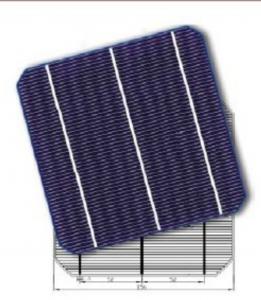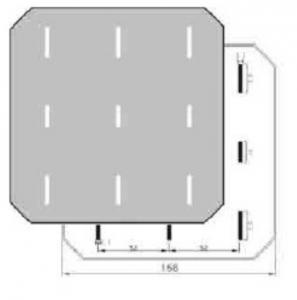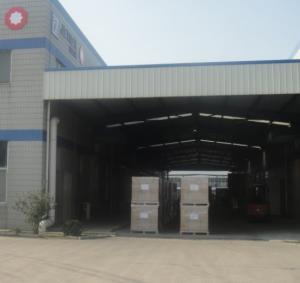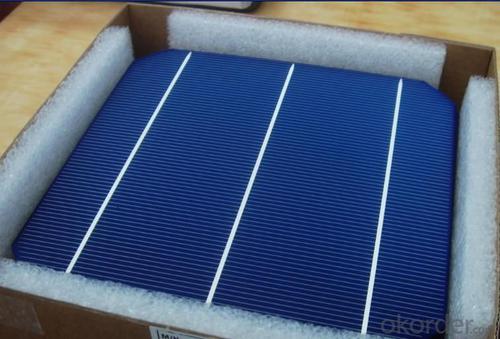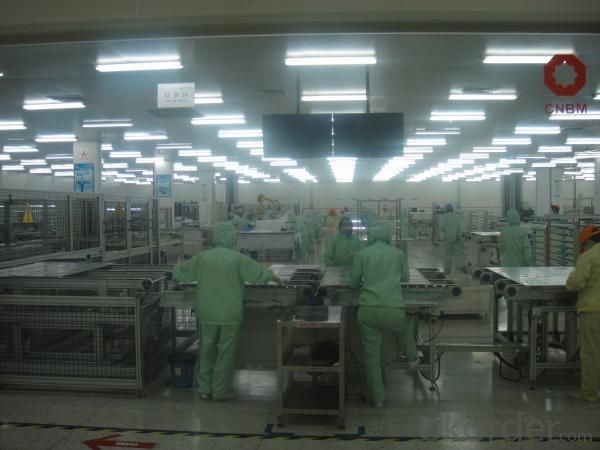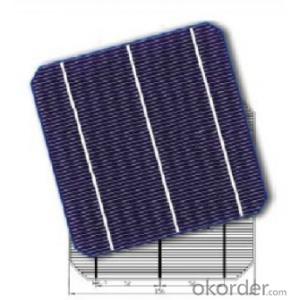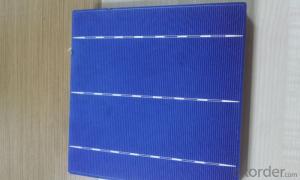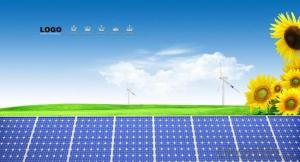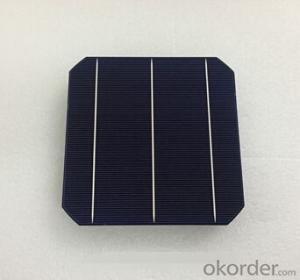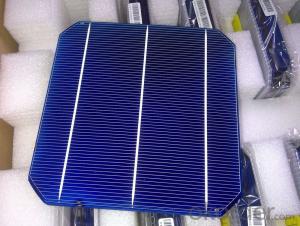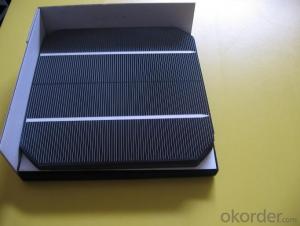Indium Phosphide Solar Cells - Level A High Quality Mono Solar Cell 156mm with TUV, CE Certification
- Loading Port:
- Tianjin
- Payment Terms:
- TT OR LC
- Min Order Qty:
- 4000 watt
- Supply Capability:
- 1000 watt/month
OKorder Service Pledge
OKorder Financial Service
You Might Also Like
Details Of Mono Solar Cell 156mm
Specifications Of Mono Solar Cell 156mm
1.Mechanical data and design
Format | 156 mm × 156 mm ± 0.5 mm |
Thickness | - 210 μm ± 40 μm |
Front(-) | 1.5 mm bus bars (silver),blue anti-reflection coating (silicon nitride) |
Back (+) | 2.5 mm wide soldering pads (silver) back surface field (aluminium) |
2.Temperature Coefficient of Cells
Voc. Temp . coef.%/K | -0.35%/K |
Isc . Temp . coef.%/K | +0.024%/K |
Pm. Temp. coef.%/K | -0.47%/K |
3.Electrical Characteristic
Efficiency (%) | Pmpp (W) | Umpp (V) | Impp (A) | Uoc (V) | Isc (A) | FF (%) |
18.35 | 4.384 | 0.526 | 8.333 | 0.63 | 8.877 | 78.3% |
18.20 | 4.349 | 0.526 | 8.263 | 0.63 | 8.789 | 78.54% |
18.05 | 4.313 | 0.525 | 8.216 | 0.63 | 8.741 | 78.32% |
17.90 | 4.277 | 0.524 | 8.161 | 0.629 | 8.713 | 78.04% |
17.75 | 4.241 | 0.523 | 8.116 | 0.629 | 8.678 | 77.70% |
17.60 | 4.206 | 0.521 | 8.073 | 0.628 | 8.657 | 77.36% |
17.45 | 4.170 | 0.519 | 8.039 | 0.628 | 8.633 | 76.92% |
17.30 | 4.134 | 0.517 | 8.004 | 0.626 | 8.622 | 76.59% |
17.15 | 4.098 | 0.516 | 7.938 | 0.625 | 8.537 | 76.80% |
17.00 | 4.062 | 0.512 | 7.933 | 0.625 | 8.531 | 76.18% |
16.75 | 4.002 | 0.511 | 7.828 | 0.625 | 8.499 | 75.34% |
16.50 | 3.943 | 0.510 | 7.828 | 0.625 | 8.484 | 74.36% |
4.Intensity Dependence
Intensity [W/m2] | Isc× [mA] | Voc× [mV] |
1000 | 1.00 | 1.000 |
900 | 0.90 | 0.989 |
500 | 0.50 | 0.963 |
300 | 0.30 | 0.939 |
200 | 0.20 | 0.920 |
Advantage Of Mono Solar Cell 156mm
1: high quality cell, Level A cell
2: Dimensione:125*125mm Diagonal:150mm / 165mm
Dimensione:156*156mm Diagonal:200mm
3: Qualified certification: TUV,CE certification.
4: Warranty: five years for whole unit
Usage/Application Of Mono Solar Cell 156mm
Monocrystalline solar cells are currently the fastest developing a solar cell, its structure and production process has been finalized, the products have been widely used for space and ground. Such solar cells with high purity silicon rods as raw materials. Silicon rods, material performance indicators in order to reduce production costs, and now solar terrestrial applications such as the use of solar grade somewhat relaxed. Some semiconductor devices can also be used for processing materials and discard the head and tail of silicon materials, solar cells after re-drawn into a dedicated silicon rods.
Packaging & Delivery Of Mono Solar Cell 156mm | |
Packaging Detai | Packaging Detail:Export Carton and Pallet or under customer request. |
Delivery Detail:10-20days | |


New Discovery of Solar Energy Material and Solar Cells
Nature prefers crystals. Salt, snowflakes, and quartz crystals are three typical examples, which is characterized by atoms and molecules are arranged in a unique lattice.
Industry also loves crystals. Electronic components is a crystal family, also known as semiconductors, the most famous is the silicon material.
In order to make semiconductor practical engineer must adjust its crystalline arrangement to control the start and stop the flow of electrons. Semiconducto r engineers need to know precisely the lattice energy of electrons required to move this energy value is called the energy gap. Similar to silicon, gallium arsenide and germanium and other semiconductor materials, they each have a unique energy gap of the crystal lattice. Through the determination of the energy gap, can determine what kind of material is suitable for electronic functions.
An interdisciplinary research team at Stanford University has successfully produced a semiconductor crystal with a variable energy gap. Such a semiconductor may be used as a solar cell, which is very sensitive to certain spectrum, from the sun to absorb more energy.
This raw material itself is not something new. Molybdenum disulfide (MoS2) is a crystalline rock, such as quartz, as a catalyst can be used to refine and lubricants.
Molybdenum disulfide is a single-layer structure: a triangular lattice of molybdenum atoms joins two sulfur. The nature of the rock is made up of many such single layer of material laminated together. Each has a single layer of molybdenum disulfide semiconductor potential applications.
Use of such a semiconductor material, we can get a great energy gap. This will have a beneficial aspect of the sensor, solar and other electronic applications.
Scientists have graphene endless praise. It found that graphene materials won the Nobel Prize, which is a single-layer structure consisting of a single layer of carbon atoms flat pendulum.
In 2012, the nuclear industry and MIT materials scientist devised a theory relates to semiconductor applications molybdenum disulfide monolayer. For any semiconductor, engineers must change its lattice arrangement so as to control the flow of electrons. For silicon, this adjustment comprises mixing a small amount of chemical substances in the crystal lattice.
Its scalability in the process is the most exciting thing. At the same time, from an industrial point of view, molybdenum disulfide very cheap.
- Q: Can solar cells be used in remote or inaccessible locations?
- Yes, solar cells can be used in remote or inaccessible locations as they do not require a constant power supply or connection to the grid. They can provide a reliable and sustainable source of electricity in areas where traditional power sources are unavailable or difficult to access.
- Q: Can solar cells be used in boats or marine applications?
- Yes, solar cells can definitely be used in boats or marine applications. They provide a sustainable and renewable source of energy to power various systems onboard, such as navigation equipment, lighting, battery charging, and even propulsion systems. Solar panels can be installed on the deck or roof of a boat, where they can harness the sun's energy to generate electricity and reduce reliance on fossil fuels.
- Q: Can solar cells be used in agricultural farms?
- Yes, solar cells can be used in agricultural farms. They can be installed on rooftops or open fields to generate clean and renewable energy. This energy can be utilized to power various agricultural operations such as irrigation systems, lighting, and machinery. Additionally, solar cells can help farms become more self-sufficient and reduce their reliance on traditional energy sources, thereby contributing to sustainable farming practices.
- Q: What is the impact of solar cells on reducing energy inequality?
- Solar cells have a significant impact on reducing energy inequality by providing access to affordable and sustainable energy sources. By harnessing the power of the sun, solar cells can be deployed in remote and underserved areas, where traditional electricity grids are absent or unreliable. This empowers communities, particularly in developing regions, to generate their own clean energy, reducing dependence on fossil fuels and promoting energy self-sufficiency. Ultimately, solar cells contribute to bridging the energy gap and promoting a more equitable distribution of energy resources.
- Q: Does solar cell cost less than the other power generation technology?
- Since it saves a lot of energy, and make less damage to the environment, it is considered less cost as a way to generate the power.
- Q: Can solar cells be used in powering RVs and campers?
- Yes, solar cells can be used in powering RVs and campers. Solar panels installed on the roof of an RV or camper can convert sunlight into electricity, which can then be used to power various appliances, lights, and charging systems. This allows for a sustainable and self-sufficient power source while on the road or camping in remote locations.
- Q: What is the right way to operate a solar cell?
- This needs professional training in solar cell operation.
- Q: What is the impact of dust or dirt on solar cell performance?
- The presence of dust or dirt on solar cells can significantly impact their performance. As these particles accumulate on the surface of the cells, they create a barrier that reduces the amount of sunlight reaching the photovoltaic material. This obstruction leads to a decrease in the conversion of solar energy into electricity, resulting in a lower overall efficiency of the solar panels. Regular cleaning and maintenance are essential to ensure optimal performance and maximize the electricity generation from solar cells.
- Q: What is the window material in the solar cell? what's the effect?
- However, since the window layer is a surface layer, the surface composite is serious, so the window layer to avoid absorbing light to produce carriers, so the window layer is generally made of large band gap material, try not to absorb light.
- Q: Can solar cells be used in parking lots?
- Yes, solar cells can be used in parking lots. They can be installed on canopies or shade structures above parking spaces, or integrated into the ground as solar parking lot tiles. This allows parking lots to generate clean and renewable energy while providing shade for vehicles.
1. Manufacturer Overview
| Location | SanShui City, Guang Dong, China. |
| Year Established | 2009 |
| Annual Output Value | Above 10 billion RMB |
| Main Markets | Mid East;Western Europe;North America;Southeast Asia |
| Company Certifications | TUV ISO9001;SGS |
2. Manufacturer Certificates
| a) Certification Name | |
| Range | |
| Reference | |
| Validity Period |
3. Manufacturer Capability
| a) Trade Capacity | |
| Nearest Port | Zhuhai, Foshan |
| Export Percentage | 0.4 |
| No.of Employees in Trade Department | about 600 |
| Language Spoken: | English;Chinese; |
| b) Factory Information | |
| Factory Size: | 66666.7m2 |
| No. of Production Lines | 12 |
| Contract Manufacturing | OEM Service Offered;Design Service Offered |
| Product Price Range | USD 0.3-0.45/Wp |
Send your message to us
Indium Phosphide Solar Cells - Level A High Quality Mono Solar Cell 156mm with TUV, CE Certification
- Loading Port:
- Tianjin
- Payment Terms:
- TT OR LC
- Min Order Qty:
- 4000 watt
- Supply Capability:
- 1000 watt/month
OKorder Service Pledge
OKorder Financial Service
Similar products
Hot products
Hot Searches
Related keywords

